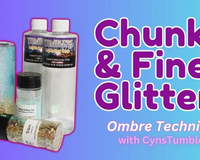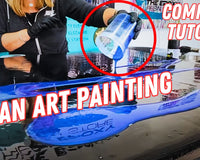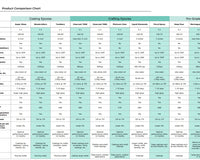Here are some of the most common FAQs and NEED to KNOW TIPS we have gathered to help you become an epoxy resin expert.
Let's get started.
What causes the epoxy resin to turn yellow?
Resins are polymer plastic and will yellow over time through oxidation. Yellowing can be caused by overheating while curing or by prolonged exposure to UV light. UV light is powerful, and when it hits resin, it can break down the polymers causing gloss loss, delamination, cracking surface chalking, and yellowing. Yellowing can also occur when mixing excessive resin quantities.
You can reduce yellowing by working in a temperature-controlled workspace (75F). You can also choose epoxy products with UV inhibitors or HALS (Hindered Amine Light Stabilizer). It can reduce yellowing by up to 95%. Here are our products that come with UV inhibitors:
When handling epoxy resin, should I use a respirator or not?
Our resins are not made from polyester or polyurethane. They are responsible for off-gassing toxins. Please use your best judgment if you have allergies or sensitivities to epoxy resin. Our epoxy resin is VOC-free. It means it does not contain elements deemed toxic as per all the safety guidelines.
Did you know temperature will affect your epoxy resin?
Both room and resin should have an optimal temperature of 70 - 78 F. Room temperature should be 70-78F while resin temperature should be 75F.
As the temperature drops, epoxy becomes thicker and will not flow properly. It is much more challenging to measure and mix the epoxy resin and hardener in cold weather, leading to incomplete mixing and a greater risk of coating failure.
The high temperature will cause a change in the molecular structure, and the epoxy will soften and cause distortion.
Do you know when to measure epoxy resin by weight versus volume?
Using our 1:1 ratio products is easiest to measure by volume. This is because the density of part A is greater than the density of part B. Nevertheless, this means they do not weigh the same, so if measuring by weight, you must use a 100:85 ratio.
Our 2:1 or 3:1 products, however, can be measured true to weight. This is because part A and part B weigh the same.
Remember: You can never go wrong when measuring by volume.
Did you know there is not one epoxy resin for all projects?
Every product works differently. Each is made for specific types of projects/pours.
This means that different products will have different min/max pour recommendations. Some products even have specific mixing recommendations.
Remember: Resins are not interchangeable. Always read the mixing instructions provided in your package, on the label, and on our website.
Did you know there is a limit to how much pigment you can add to epoxy resin mixture?
You should only use a pigment quantity of up to 5% of the total mixture. For example: When mixing 50 grams of epoxy resin, you should only use 2.5 grams of pigment. Adding too much mica powder can make your resin lumpy. Exceeding 5% with liquid pigments can cause a soft cure. Adding pigments will bring down the overall hardness and should be used sparingly. Adding an excessive amount of pigment to the epoxy could alter the resin/hardener ratio, compromising cured epoxy performance.
Did you know epoxy resin mix ratios matter?
The different mixture ratios that we manufacture are 1:1, 2:1 and 3:1.These ratios are always read as part A: part B. Example: 2:1 = 2 parts A and 1 part B. 2:1 and 3:1 mixtures will have a lower viscosity than a 1:1 mixture. This means that a 3:1 mixture would be more fluid like water and a 1:1 mixture would be more similar to honey. Ratio information can always be found in the mixing instructions. Another tell-tale sign is the size of the bottles. But always be sure to read the product description before purchasing!
Top 3 Mixing Mistakes to avoid for Flawless Epoxy Resin
Don't mix your resin if it is too hot or too cold. Get it to a room temperature of 75F. Too hot can cause a flash cure, and too cold can make the resin cloudy and interfere with the chemical reaction. Always make sure to mix efficiently. That means 5 minutes or until striations are gone. Not mixing enough can cause the resin to not cure properly or cause part of the pour not to cure. But remember not to mix too fast as this can cause bubbles. Also, never mix unapproved pigments into your resin. It can interfere with a proper cure.
Do you know how to quickly calculate the amount of epoxy resin you'll need for a project?
Just go to our website https://www.theepoxyresinstore.com/ and scroll to the bottom of the page. Then, click on Epoxy Resin Calculator. Enter the dimensions of your pour. And just like that, you'll know how much you need!
Did you know your local weather patterns will affect your epoxy resin?
Working in a hot garage or anywhere above the recommended 75F can cause a flash cure. Flash curing can lead to issues with overheating and microbubbles. So, always be sure to get your resin to room temperature before mixing and work in a temperature-controlled workspace.
Warmer temperatures will accelerate the chemical reaction, while colder temperatures slow the reaction down. Both will directly affect the epoxy's cure time and physical properties. In addition, the temperature affects the handling properties of epoxy resin.
Do you know the difference between maximum heat resistance and intermittent heat resistance in epoxy resin?
Maximum heat resistance is the maximum temperature an epoxy can withstand at extended periods of time while intermittent heat resistance is the maximum temperature an epoxy can withstand for a brief moment. Most of our epoxies have a maximum heat resistance of 165F and a maximum intermittent heat resistance of 300F. With the exception of Epoxyseal 9000 which has a maximum heat resistance of 130C. Exceeding these temperatures will cause the epoxy to become malleable and risk warping. So, remember to be careful with where you keep and how you use your epoxy pieces.
Do you know the difference between work time, cure time, and full cure?
Work time is the time before curing begins to set in and the resin becomes tacky. Most of our products have a 45 min work time.
Cure time is the time that it takes for the resin to become hard enough to be handled. Most of our products have a 24-hour cure time.
Full cure time is the amount of time it takes for the resin to reach its peak hardness/rigidity. Our products take 7-10 days for a full cure.
Though a 24-hour period can provide a pretty rigid cure, we recommend allowing the full 7-10 days before using the piece for any practical use.
Did you know epoxy resin gets hot during the cure?
Epoxy Resin will get hot as it begins to cure. This is because the resin and the hardener undergo an exothermic chemical reaction. Depending on the product in use, the resin can reach peak temperatures of 130F-170F in a room-temperature workspace. Pouring more than the recommended depths/volumes can catalyze this reaction and cause the resin to hit much higher temperatures. If your epoxy overheats while curing, it can cause yellowing, shrinkage and even cracking in extreme cases. So always be sure to follow the pour recommendations for each product. And if your project does overheat, use a fan or AC to bring the temperature back down.
Do you know what low VOC epoxy resin stands for?
VOC stands for Volatile Organic Compounds. Our resin has low VOC and does not contain harmful chemicals like polyester or polyurethane. This makes our resin easy to work with and leaves PPE up to customer discretion.
We hope this was helpful.
**If you made it this far down, We occasionally pick the best comment to win a giveaway. -hint-hint
We created a handy comparison guide to help understand the different properties of our epoxy resin. Just follow this link here https://www.theepoxyresinstore.com/blogs/news/what-epoxy-resin-is-best-for-my-project
https://www.theepoxyresinstore.com/ is an expert manufacturer of various epoxy resins that can be used for both craft projects and industrial applications. We also offer colors, pigments, glitter, and other additives for various epoxy resin projects.
The Epoxy Resin Store
support@theepoxyresinstore.com
Phone: (951) 677-0400
Address: 540 Crane St suite A Lake Elsinore, CA 92530
https://www.theepoxyresinstore.com
Social Accounts:
https://www.facebook.com/TheEpoxyResinStore
https://twitter.com/epoxyresinstore
https://www.linkedin.com/company/the-epoxy-resin-store
https://www.youtube.com/channel/UC3NKcCrYL5uHK-sH5XMQ9HA
https://instagram.com/theepoxyresinstore













6 comments
Jack
Thanks for the detailed information! I’ve been looking for a room temperature cure epoxy that will work with a black car in Texas summer sun and heat. Most I’ve found only work up to 130*F without post processing in an oven (impractical for me right now). Your 165*F provides the margin I need for my application. Glad I found your site! 😊.
BTW, does post heat processing improve the temperature resistance of your epoxy if I get the capability to do that in the future?
Erin Ridley
I love that you provide all this information and that it is easy to find on your blog! It helps so many people fear over their “fear” of resin! I share your site all the time. Thank you!
Caitlin
Thanks for these tips! I’m working on using dyes with epoxy to use on the backside of polished stones to use for my jewelry, so this has been really insightful to help reduce the problems that I sometimes have. I had been using some water-based inks in epoxy with some success and some failure, so it’s been hard for me to determine whether it’s the fact that the surface wasn’t prepped well enough for a good physical bond (surface may have been too smooth since the epoxy kind of came off in a sheet), or if it was that I went over board with the dye, or if the dye isn’t compatible after all.
Do you know if matte powder pigments (not the kind that have mica in them, but more like the ones that painters would use to make oil paint) would be compatible with epoxy? Like oxide pigments, or the like?
Gina Szpak
I am President of a 501-c non for profit looking to create a community art fundraising project . I am wanting to create a rebar tree that has resin leaves that the community can make and attach to the tree. Is this possible to create this outdoor art with longevity ? Please help ;)
Caprina
Love your products. Q: what causes epoxy to get ripples on a tumbler while on a turner?
Amber Pasternak
Wow! Thank you for organizing this. Great info, super helpful as I am just beginning to learn about epoxy resin and how to use it for my art projects. love this.